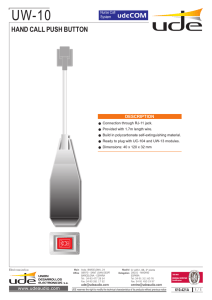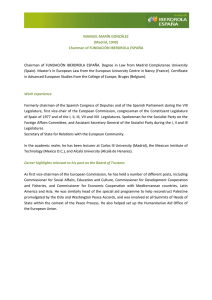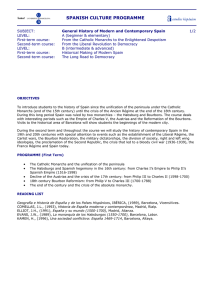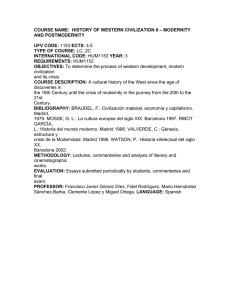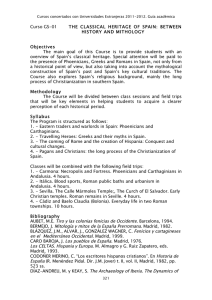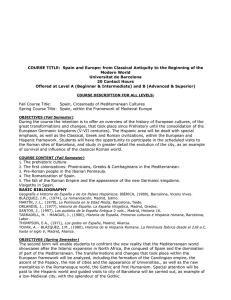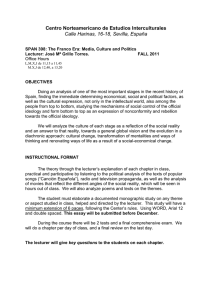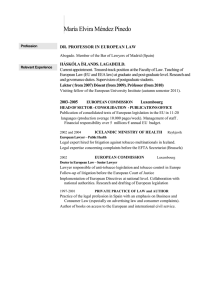State of the Art – Spain Spanish literature from migrant
Anuncio
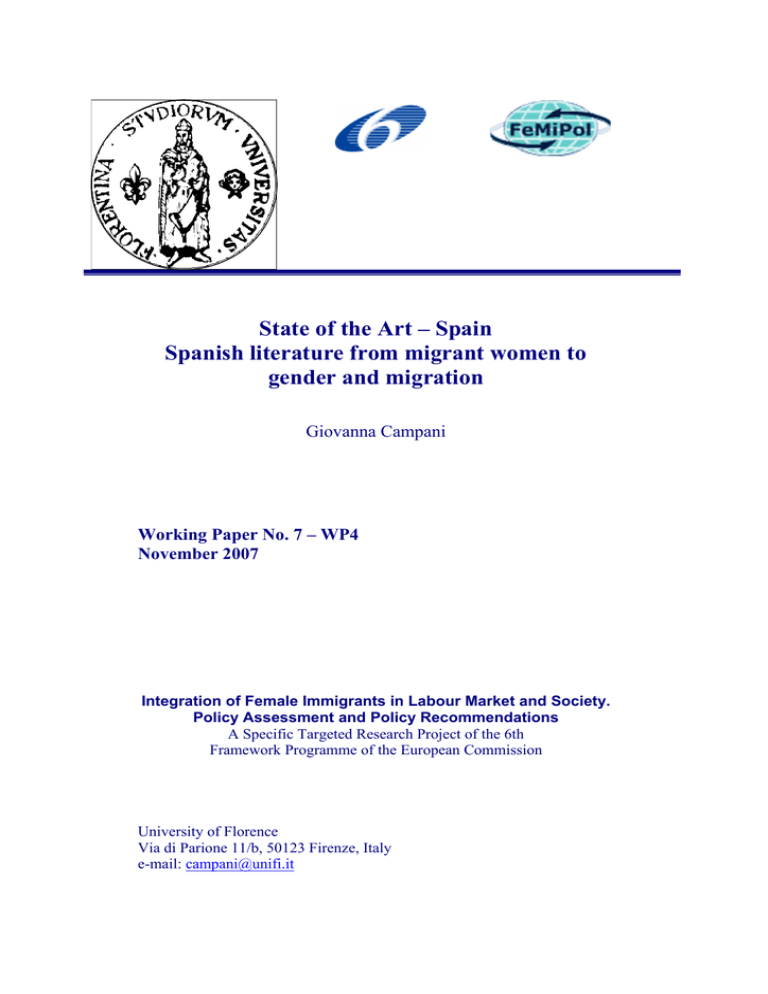
State of the Art – Spain Spanish literature from migrant women to gender and migration Giovanna Campani Working Paper No. 7 – WP4 November 2007 Integration of Female Immigrants in Labour Market and Society. Policy Assessment and Policy Recommendations A Specific Targeted Research Project of the 6th Framework Programme of the European Commission University of Florence Via di Parione 11/b, 50123 Firenze, Italy e-mail: campani@unifi.it Giovanna Campani University of Florence Mª del Rocío Cárdenas Rodríguez Itahisa Pérez Pérez Universidad Pablo de Olavide Introduction Research on immigration in Spain dates back to the mid- Eighties, when the Organic Law 7/1985 on the Rights and Freedoms of Foreigners in Spain was approved, and a first regularisation took place in 1985-1986. The second “extraordinary” regularisation process between 1991 and 1992 showed the spectacular growth of the immigrant population, and gave many new statistical data for research. Before that time, research topics were emigration out of Spain and internal migration from the Southern part of the country, mainly Andalusia, into Catalonia and the Basque Country. Since the early Eighties, attention was also paid to the settlement of North-European aged people spending their retirement years under the Mediterranean sun1, that is to say on the Spanish coasts and islands. It is, by the way, interesting to notice that the same scholars who were active in researching Spanish emigration or internal migration performed also first researches on new immigrants to Spain. This is namely the case of the Madrid research centre, Colectivo IOE, which published in 1987 the first comprehensive study on immigration to Spain: Los Inmigrantes en Espana, Colectivo Ioé, Documentación Social Madrid: Cáritas Española, nº 66, January-March, 1987. It is an important sociological study, focusing on economic immigrants in the period between May 1984 and mid-1986, which offers a first overview of the origin of immigrants, their settlement, labour conditions, education, and reception structures. Other comprehensive studies were produced with the support of institutions as, for example, the book of Izquierdo Escribano, Antonio, La inmigration en España, 1980-1990, Madrid: Centro de Publicaciones Ministerio de Trabajo y Seguridad Social, 1992 (Informes Serie general; 1 7). The arrival of foreign immigrants from developing countries was a fast spontaneous process, responding to the needs of the expanding Spanish economy, and had a significant socio-demographic impact, forcing the government to implement migratory policies. The government’s choice was to act in the frame of the EU directives, by focusing flows control, especially urgent for a country that is – geographically – one of the gates leading towards the European Union2. Moreover, the Government opted for a policy of “extraordinary” regularisations – similar in fact to the ones acted by the Italian government. As mentioned, the regularisation process – occurred between 1991 and 1992 – represented a collection of quantitative data, that scholars could use to analyse the socio-demographic reality of immigration in 1 A few studies on European Union immigration towards Spain, mainly of elderly people, have been carried out mainly by non-Spanish scholars. Accordingly, these studies present images of foreign women mainly as tourists, not as immigrants coming for work. 2 Spain signed the Schengen agreement on November 18th, 1991. This means that decisions adopted by various governments had as priority a legislation of control and limitation of migratory flows directed to Spain. 2 Spain. In the regularisation process, the importance of migrant women appeared in its quantitative dimension: in 1992, women represented 47% of regularized immigrants (subsequently, they covered 48% of the foreign population until the beginning of 2000; they are 45% now3). Data emerged from the regularisation represented a very important basis for the first researches on women migration in Spain, which attempted to offer a socio-demographic picture of this presence in the passage of Spain from emigration to immigration country. These first quantitative descriptive studies put in evidence the variety of pathways that brought about their incorporation into the labour market, according to their origins: women come either alone for doing domestic works (Latin American women, Filipinas) or in family reunification legal frames (Moroccans and Gambians). In the early Nineties, being aware of the variety in migratory pathways, scholars have begun to develop qualitative researches, based on interviews and life stories, or on ethnographic observation, contrasting the stereotyped image of “immigrant woman”4. Qualitative studies can be comparative, taking into account various national or ethnic populations, or can just focus on particular immigrant group. Among these studies, a certain number concern the Maghrebian/Muslim/Moroccan women, following the debate topics – that have been frequently used in France, Germany, and in Europe in general – about Islam, women and modernity, the question of the veil, etc… From the late Nineties onwards, research on women’s migration starts to adopt a gender perspective: more studies tend to show how the female migration is raising crucial questions involving gender relations in a worldwide scenario. The complex relationship between women from rich and poor countries in front of domestic work is, of course, a crucial point, combined with the emotional impact provoked by the so-called “transnational families”. During the Nineties, scholars produced first bibliographical overviews, in front of a considerable number of researches on women’s migration. In 2000, Gemma Aubarell, from the University of Barcelona, writes Una propuesta de recorrido bibliográfico por las migraciones femeninas en España, Papers. Revista de Sociologia, Universitat Autònoma de Barcelona; a few years later, María GarcíaCano Torrico, from the Laboratory of Intercultural Studies of the University of Granada, wrote an article on the literature on «L’immigration non-communautaire féminine vers l’Espagne», published in the Revue Européenne des Migrations Internationales. We can state that, even if the number of studies on women’s migration is limited in comparison with old immigration countries as France or the UK, in the space of fifteen years, the Spanish literature on women’s migration has quickly developed an interesting debate on crucial points in gender issues, offering a much-diversified landscape. It must also be stressed that not only the academic world produced Spanish literature on migrant women, but also political institutions and NGOs, having a militant approach. Some of the Spanish academics are engaged as well, by the way, in the civil society for the migrants' rights and the fight against racism. We can also wonder, in Spain, in the last years, at which point research on gender and migration has profited of the debate on women’s condition and the fight for concrete policies improving general women’s position in the Spanish reality. 1. First studies on female migration: from a quantitative to a qualitative approach The first studies on migrant women in Spain are published in the late Eighties and early Nineties5. As Gemma Aubarell states (2000, p. 398)6 in her overview on the literature on female migrations in 3 Source: Instituto de la mujer, Madrid, www.mtas.es/mujer . There was a parallel between the development of this type of qualitative studies in Italy and in Spain as we have described in the state of art for Italy. 5 Among the first researches on migration issues, during the Seventies and Eighties, there were researches concerning internal migrations of Andalusians or Extremeños reaching new poles of industrialisation in Catalonia or in the Basque Country. It is, consequently, in the Catalan and Basque’s Universities that sociology of migration and intercultural studies are more developed when Spain becomes an immigration country. 4 3 Spain, these studies answer the “need to understand the statistical reality starting from the data coming from the regularisation process.” They are, in fact, quantitative researches, mainly descriptive, taking into account socio-demographic data of migrant women, as their native countries, status (married, single, etc..), working activities, and settlement conditions. These socio-demographic studies have no gender approach: they count “the women in terms of stock”, the sex being a variable as the age, civil status or education. As an example, we can mention – at national level – a research of the Fondacion CIPIE (1991), Mujeres del Tercer Mundo en España. Modelo migratorio y caracterización socio-demográfica, Ed. Fundación CIPIE, Madrid, 1991. Local contexts are analysed by Pumares (since early '90s), looking at the Autonomous Community of Madrid; by the Association of Human Rights of Cadix (1996); by SOS Racisme-SOS Arrazakeira (1997) considering immigrant women in Navarre. The data emerged from the regularisation process completely question the image of migrant woman as a passive woman, accompanying her husband or partner – image that had been used for the study of Spanish emigration abroad. On the contrary, it appears that “new” migrant women have an active role in the migration process, being “demanded” as much as men by the Spanish labour market. An important field of study is the one analysing the position of women in the labour market in a class perspective. Among the first studies on labour market and women’s migration, we can mention – for the quality of information and analysis – a pioneer work on domestic service, the most important sector of employment in Spain, produced by the Collectivo IOÉ of Madrid Trabajadoras extranjeras de servicio doméstico en Madrid, España (1991). The International Labour Office financed the research. The importance of studying immigrant women and labour market turns out to be evident from the collected data. As for numbers, if the employment rate of the foreign population in general significantly exceeds the rate of the Spanish population, in the case of women, the difference reaches up to ten points: 60,5% among foreign women, and 50,7% among Spanish women aged between 1664. The great majority of foreign women work in the service sector and in branches of that activity: they are basically concentrated in the home sector (including care services, family assistance, etc.) that employ domestic workers/staff, and the hotel trade/industry. It is consequently important to understand what is happening in the field of services and care work with the arrival of immigrant women. The demand in female labour force by the Spanish labour market is, however, just one of the elements at the origin of female flows, which are the result of a complex interaction between economic, historical and political factors, connecting both the sending and receiving countries (Portes et Böröcz, 1992). If the Spanish labour market needs mainly immigrant labour forces in services (mainly domestic work), that is female labour force, the context of origin is also important. Data show in fact that the female component appears to be the central settlement axis just for some immigrant groups as Dominicans, Colombians, Brazilians (composed by a majority of women up to 70%), followed by Equatorial Guinea, Ecuador, Mexico, Peru, Philippines, Cuba and Russia (around 60%). On the contrary, flows coming from Morocco, Sub-Saharan Africa (Senegal, Niger, Gambia), with the exception of Equatorial Guinea and Pakistan, are mainly composed by men7. 6 See Aubarell Gemma (2000), Una propuesta de recorrido bibliográfico por las migraciones femeninas en España, Papers. Revista de Sociologia, Universitat Autònoma de Barcelona, 60, pp. 391-413. See also Aubarell Gemma et Ribas Matteos Natalia (2000), ¿Qué respuestas? Políticas en clave de género, in M. A. Roque (ed.), Mujer y migración en el Mediterráneo Occidental, Barcelona, Institut Català de la Mediterrània /Institut Català de la Dona, pp. 319-340. 7 The men/women ratio seems to be stable: between 1992 and 2000, the number of women grows more than the number of men for Latin-Americans, but also for Africans, due to the family reunification process. 4 The great variety of migrant women’s trajectories is shown by a comparative approach between groups, as in Carlota Solé's book8, LA MUJER INMIGRANTE, Solé, Carlota, Madrid: Ministerio de Asuntos Sociales, Instituto de la Mujer, 1994 /Estudios; 40), published in 1994. Solé’s study aims at analyzing the socio-economic situation and the problems of social marginalization and discrimination of migrant women in Spain. The author uses the grid of the triple oppression – race, class and sex – that, since the Eighties, has been considered a “trinity formula” to analyze migrant women’s position. “Immigrant women coming from the Third World, of different races and cultures, must face racist oppression, beyond the ones bound to their social class and sex. These three dimensions of the oppression put immigrant women in a position of extreme subordination in respect with power relations inside a society.” The study represents the shift from a quantitative socio-demographic approach to a qualitative approach, and – from this point view – it represents a precursor in a new type of research. The methodology used consists, in fact, of interviews with the three main groups of migrant women – Maghrebians, Africans and Asians, in three Spanish cities: Barcelona, Gerona and Madrid. Thanks to its comparative dimension, the study points out the great differences in work and life conditions among the groups, an important outcome, which further research will have to take into account: «Obviously, we have to differentiate work and life conditions of various groups of immigrant women coming from countries having different economic conditions and cultural traditions, in order to understand concretely which forms of marginalisation and discrimination have to be faced.” (Solé, 1994, p. 15). 2. Diversified trajectories of migrant women and ethnographic observation. The Muslim women knock on the door… In her book, La Mujer inmigrante, Carlota Solé considers the question of immigrant women’s situation a crucial point to understand settlement and integration processes of all immigrants, because migrant women face specific forms of discrimination in combination with their class position. However, these forms of discrimination vary according to the differences in the migratory trajectories depending on the countries of origin. Women who come alone for domestic work as the Filipinas do not face the same forms of discrimination as women who come for family reunification and experience life in patriarchal traditional families as the Moroccans. It is important to explore and develop two main fields of research: the qualitative analysis of different trajectories, on one side; and the position of migrant women in the labour market and the Spanish society, articulating the class-sex-race “trinity formula”, on the other side. It is in the combination of these two approaches that researchers of the most recent studies choose the gender dimension. The awareness of differences in the trajectories of migrant women (in connection with the contexts of origin) lies at the origin of various specific studies on different groups, some of which clearly opt for qualitative methods. We focus on a few works that are characterized by ethnographic methodology which is used for their scientific interest and quality. Their object is just one immigrant community, ethnically defined, or a territory characterized by a high proportion of immigrants. We remind in this group of studies, Adriana Kaplan's work on Senegalese and Gambians in Maresme, those of Luis Miguel Narbona Reina on Moroccans in Viladecans, and Josep Miguel Palaudarias's works on Moroccans in Girona; Kaplan and Narbona have been the first authors to use a clearly ethnographic approach in researches on migration (Kaplan, 1998; Narbona, 1993). 8 It can be reminded that Carlota Solé, professor at the Autonoma University of Barcelona, is one of the best-known authors who has analysed integration processes of internal immigrants, namely through education. While Spain is becoming an immigration country, Carlota Solé starts to work on foreign immigration into Catalonia, trying to compare the situation of Spanish and non-EU migrants in the Region. 5 The idea behind these researches is that cultural and ethnic diversity represents a possibility for the Spanish society to become open and varied, and that the respect for differences is a moral and political duty. This approach corresponds, by the way, to development of a progressively “varied” Spain through the process of decentralization and the autonomy of provinces. The respect for cultural diversity, brought by immigrants, combines with the discourse for a diverse country, where Catalonia can express its specificity with the goal of achieving a plural democracy. Nevertheless, the diversity expressed by various immigrant groups does not present the same challenges for the Spanish society. As in other parts of Europe, the growing presence of Muslims is raising various types of questions in relation to their demands of public recognition, namely in relation to women’s position (the issue of the veil). The Moroccan/Maghrebian/Muslim community has been object of research in Spain since the early Nineties. First works appeared in Catalonia: Joseph Manyer (1992) publishes, in Catalan, Quan l’Islam truca a la porta. Per a una aproximació cultural als musulmans de Catalunya (Barcelona, Altafulla), in 1992. The book intends to show the ignorance and the incipient worry existing in the Catalan society in relation to the “cultural worlds” brought by foreign immigration, especially by the increasingly visible settlement of an African and Moroccan communities, having common references in Islam. In 1993, Bernabé López García edits a book Inmigración magrebí en España. El retorno de los moriscos (Madrid, Mapfre), covering the whole Spain. The reflection about the difficult interaction between Spanish people and Arabs is combined with the presentation of results of the first field researches, performed in various regions of the country, in order to offer an overview of the Moroccan and – to a lesser extent – Algerian community. In the same year, Lopez (1993a and 1993b) and Vidal (1993) published the first researches on Moroccan women. These publications are mainly sociodemographic researches. Troyano (1994) studies the condition of Maghrebian women in the Province of Malaga through a quantitative study by focusing the analysis on existing data. Finally, in 1995, a selection of articles, compiled by Montserrat Abulmahan, Comunidades islámicas en Europa (Madrid, Trotta), is published in the attempt of comparing the Spanish situation with the rest of Europe. Various reasons contribute to the interest for Moroccan /Muslim women in the Nineties: first of all, Moroccans are, at the time, the most numerous group of immigrants; secondly, a traditionally monoreligious country as Spain is confronted to a new religious minority – the Muslims. There are also, possibly, other reasons, related directly to gender issues. A crucial topic is the change in women’s condition in the former “patriarchal” Mediterranean Spanish society, while a sort of «State feminism» (the establishment of Instituto de la Mujer is an example) accompanies, in the same time, feminist movements. Analysing the condition of Moroccan-Muslim women is also a way to measure the extent of the change affecting women that has occurred in Spain. 3. From the class perspective to the gender approach We have said that studies on migrant women and labour market began with the already quoted Colectivo IOE book on Trabajadoras extranjeras de servicio doméstico en Madrid, España (1991), a research financed by the International Labour Office. It is the same Colectivo IOE that, ten years later, publishes Mujer, Inmigración y Trabajo (2001), the result of a research work realised during the years 1999 and 2000. This research tries to cover the main settings of economic inclusion of immigrant (non-community) women. This objective supposes to identify and study these occupational segments and, secondly, intends to obtain a transversal and overall vision of labour-economic dynamics of this population. Between the first study produced by Colectivo IOE in 1991 and the one of 2001, the debate on domestic work, migration and gender has gone beyond the question of exploitation and discrimination in a class perspective. Among Spanish researchers, it is especially Sonia Parella Rubio (2000) who tries to relate a complex set of economic, social and demographic factors in relation to domestic work. Among these factors, it is necessary to consider the changes concerning the family: the entry in the 6 work world of women belonging to generations born after the war, also consequence of the schooling increase, and the low birth rate. The protagonists of these changes have been women, whilst the division of tasks inside the family has changed a little. Even if new male generations are a little more conscious that they have to collaborate in the homework, their attitude is limited to give just single helps, while women keep indicating the tasks to be done and how they have to be accomplished. “Therefore we can conclude that the greater participation of the woman in the productive sphere, during last years, requires a reduction of her time presence at home, without having a comparable reduction of the domestic tasks.” (Sonia Parella Rubio, 2000, p. 282). Consequently, there is a link between the progressive incorporation of Spanish woman into the labour market, and the increase of working places in the domestic sector, in which immigrant women are preponderantly present. Many studies and debates focus on this topic. The burden of domestic work is diverted to foreign women employed as domestic workers. If this situation has partly solved the problem of conciliation among the family and working life, it has not implied an advance in distributing the housework between women and men. The same ideas are developed in a recent study conducted by Vicens Otero, entitled El impacto de la inmigración femenina en la economía española, and published by Instituto de la Mujer (Institute of the Woman) in 2005. This study analyses the importance that the employment of female immigration plays in domestic service, children and elderly care in Spain, in the frame of economic and social evolution of the Spanish population. On June 26th, 2006, the same Instituto de la Mujer subsidised the study El impacto de la inmigración femenina en la economía española (The impact of the female immigration in the Spanish economy). This work took place during the period January-December 2005 with the goal of analysing the importance of female immigration in Spain, and of assessing its economic contribution. In these studies, we can testify a progressive passage from a class perspective to a gender one. It is not only, however, the relationship between the Spanish and the immigrant women that is considered in the Spanish literature. Scholars analyse the position of immigrant women inside the international work division, in connection between sending and receiving countries in the context of globalization. While Barbara Ehrenreich and Arlie Russell Hochschild write Global Woman, denouncing the effects of globalisation on the female work and the exploitation of women by other women in domestic services, several Spanish scholars do researches in this perspective by using a gender approach. The connection between gender and globalization has been developed in Spain since the mid-Nineties by a certain number of scholars, among whom the most famous is the anthropologist Dolores Juliano. Her work is mainly theoretical, touching various gender issues (representations of women in popular culture, media, gender relations in Mediterranean societies, etc.). In her work, however, she also deals with migration and gender. (See, as well, the intervention of Dolores Juliano at the Barcelona Mediterranean Social Forum 2005 of Women and Migration). Since 2002, she has been also working on prostitution, considering this sector as one of the most stigmatized, which the same groups of migrant women denied. She has also questioned the notion of trafficking through her work D. Juliano, La prostitución: el espejo oscuro (Barcelona: Icaria / Institut Català d'Antropologia, 2002). 4. The gender approach in Spanish literature on women’s migration The gender approach, as developed in the Spanish studies, is based on two important points: first of all, migratory movements are seen in the frame of the North-South relations, and – more generally – the globalization process; secondly, they connect economic changes with the study of patriarchal structures provoking inequalities between women and men at the level of labour market, family structures and social help. 7 The work done by Gregorio (1998) on the Dominican Republic community in Madrid is an excellent example of the gender analysis of migrations towards Spain. Starting from an ethnological perspective, the scholar considers the factors that, in the society of origin, push women more than men to migrate. Aspects studied by Gregorio consider factors that provoke the migration, forms in which women organize themselves during this migration, and their impact on the societies of origin as far as the relations between genders are concerned. One of the most interesting conclusions of this study is that the Dominican migration in Spain “answers to the reproduction of the non egalitarian system among sexes that characterizes the society of origin,” while “the economic, political and ideological relations that are put in place in the new context” of the receiving society, may play a role in reinforcing or weakening this system of inequality. One of the most interesting aspects of the studies with a gender approach has been the introduction of a multi-level analysis of migratory phenomena. Scholars connect the macro-social (economic and political) factors and the micro-social ones (family, social networks, etc.): what is the relationship of women’s roles to their position of gender inequality. It must be underlined that many studies take the whole migratory trajectory into account – from sending country to Spain (Ramirez, 1998; Gregorio, 1998, Suarez, 1998; Ribas, 1999). This researcher's immersion into the whole migratory process appears to be a key element for analysing and interpreting trajectories connected with sex, for analysing the factors provoking migration, as well as for studying factors that encourage the transformation or the status quo of gender structures. In this perspective, the work of the already quoted scholar Parella Rubio S. is particularly interesting, considering at the same time difficulties in the labour incorporation and new forms of organisation of gender relations as the “transnational motherhood”. Let us quote some of her interesting works in this field: Nuevas formas de maternidad, 2004; Els negocis ètnics a Catalunya, 2004; El uso de las políticas sociales por las mujeres inmigrantes, 2004; Inmigración comunitaria. Discriminación inversa, 2004; Políticas de integración de inmigrantes. Sociedades de emigración y sociedades de inmigración. Un estudio comparativo, 2003; La mujer inmigrante en los servicios de proximidad o el trasvase de desigualdades de clase y etnia entre mujeres, 2001; among others. In 2005, she published the article entitled: La vulnerabilidad social de las mujeres inmigrantes no-comunitarias a partir del estudio de sus pautas de inserción laboral en España, by which she tries to identify the theoretical frame and the social context determining the labour inclusion of non-community immigrant women, and to present their main labour-inclusion pathways; this work begins from analysis of the statistical data relating to the women of non-community origins working in Spain, and ends by planning possible directions of intervention. After 2000, scholars increasingly use this gender approach, while the active role of women in migration appears to characterise as well Maghrebian countries. In 2004, the mass arrival of pateras9 inspired Dolores Soler-Espiauba to publish (as coordinator) the book Literatura y pateras (Madrid, Akal; Sevilla, Universidad Internacional de Andalucía). Beside this work, two journalists accompanied 34 Africans during their dramatic journey aimed to reach Spain in Yo llegué en patera, by Deniau y Jobard (El País Semanal). Even in irregular migration, women are present. 5. Migrant woman, trafficking and prostitution We have quoted the work of Dolores Juliano (2002) in relation to the issue of trafficking and prostitution. According to her, the group of immigrant women that suffer a major legal discrimination and social mistreatment are the sex workers. Moreover, in the last years, the mass media have taken upon themselves the task of stirring the social alarm up, as far as they construct the image of 9 In jargon: boats, watercrafts by which immigrants are clandestinely transported. 8 immigrant prostitute woman with superficiality, too antiquated moralist perspective, and strong dose of sensationalism and falseness. Besides Juliano, other scholars have begun to deal with the topic, as AGUSTÍN, Laura María (2004), Trabajar en la industria del sexo, y otros tópicos migratorios, Gakoa/Tercera Prensa, Donosita, Solana, Ruiz, José Luis (2003), Prostitución, tráfico e inmigración de mujeres, Comares, Granada (2005), «Mujer inmigrante y prostitución: falencias y realidades», in Francisco Checa (ed.), Mujeres en el camino, Icaria, Barcelona, pp. 221-257. These researches point out that there is a large variety of origins (Africa, Latin America and Eastern Europe), and situations of migrant women working in prostitution. Without despising the importance and quantity of women who are deceived and forced by networks of trafficking in human beings, these studies tend to show that many immigrant women have opted for doing a sexual work, by starting from an assessment of costs and benefits that this activity implies for them. By attaching them the label of “victims”, one only arrives at perpetuating their social marginality and exposing them to a major violence. These studies insist as well on the fact that, although the prostitution is not a penalised activity in Spain, its non-recognition as working activity and the strong social stigma accompanying it, provoke the fact that the community of female prostitutes see their most fundamental rights constantly trampled and violated. In the case of immigrant women practising the prostitution, the discrimination becomes even worse, considering that they cannot legalise their situation in the country by regularising their working activity. Many studies denounce the position of irregular immigrants (and especially female immigrants – in any activity) as extremely vulnerable. This vulnerability appears in relation with domestic violence and gender-based violence. In Spain, undocumented migrant women are legally considered as individuals having rights in front of the gender violence, or having no fewer guarantees than the rest of victims of this kind of abuse, as for the protection of their rights to life and personal security. In January 2005, Ley Orgánica de Medidas de Protección Integral contra la Violencia de Género (Organic Law of Measures of Integral Protection against the Gender Violence) came into force. This Law disposes in its Art. 17.1 that “all the women, victims of gender violence, independently from their origin, religion or any other personal or social condition or circumstance, have guaranteed the rights recognised in this Law”. Likewise, Art. 30.2 establishes that “the situation of the women who, for their personal and social circumstances, could run the major risk of suffering the gender violence or major difficulties while accessing the services envisaged in this Law, such as members of minorities, immigrants, those who find themselves in situation of social exclusion or the women having disability, will be considered in particular way within the actions envisaged by this article.” Both articles observe the relation with the principle of no discrimination in the protection of human rights, by which the Spanish State, in this case, is obliged. With this measure, Spain did a first step with the goal of eliminating arbitrary distinctions, and undertaking corrective and positive measures, aimed at guaranteeing the rights to life and personal integrity to the women in conditions of particular vulnerability. However, the Report, realised by the Spanish Amnesty International (2005), and entitled Inmigrantes indocumentadas, ¿hasta cuando sin protección antes la violencia de género?, insists on the fact that the principle of non discrimination must be brought into the field of concrete measures and practical application, and not remain confined to the rhetorical field, so as to clearly reflect the political willingness of the State in front of gender violence. The following paragraphs deepen over the forms that the said discrimination takes, and propose concrete recommendations to the central Government 9 and to autonomous governments. In fact, the condition of undocumented immigrant women appears to be one of the particularly vulnerable sectors, due to their administrative status. Conclusions We can conclude that research on women’s migration in Spain has started with a quantitative approach in order to arrive at developing a gender perspective. Present-day scholars are aware of the central role of migrant female workers in labour market and theoretical importance for gender relations. In the working environment, their presence in certain branches (domestic service, personal care, cleaning and housework) seems to show a tendency of “ethnicisation” of important working fringes dedicated to personal care and assistance. The gender condition marked these works since their origins (as a prolongation towards the market of works typical for the family sphere, traditionally assigned to the women). As far as gender relations are concerned, migrant women play a crucial role in organising domestic and extra-domestic spaces, such like their specific place inside homes, some of them spatially split between the country of origin and the country of destination (with new phenomenon like, for example, the transnational maternity). Thereby, female migration to Spain represents an idealtypic phenomenon where gender, working and national-ethnic determining factors are meeting. BIBLIOGRAPHICAL REFERENCES: ALBIOL Soto Marta (coordinator) (2005), La rueca: estudio sobre proceso de inserción sociolaboral en mujeres inmigrantes, Sevilla : Andalucía acoge, D. L. AUBARELL Gemma, RIBAS Matteos Natalia (2000), ¿Qué respuestas? Políticas en clave de género, in M. A. Roque (ed.), Mujer y migración en el Mediterráneo Occidental, Barcelona : Institut Català de la Mediterrània/Institut Català de la Dona. AUBARELL Gemma (2000), Una propuesta de recorrido bibliográfico por las migraciones femeninas en España, Papers. Revista de Sociologia, Barcelona : Universitat Autònoma de Barcelona. ANDRÉS-SUÁREZ, I. (2002), La inmigración en la literatura española contemporánea, Madrid : Editorial Verbum. BAÑÓN HERNÁNDEZ, A. M. (2002), Discurso e inmigración: propuestas para el análisis de un debate social, Murcia : Universidad de Murcia. BARDAJÍ RUIZ, F. (2006), Literatura sobre inmigrantes en España, Documentos del Observatorio Permanente de la Inmigración, Ministerio de Trabajo y Asuntos Sociales. BLANCO Cristina (2000), Las migraciones contemporáneas, Madrid : Alianza Editorial. CHECA, F. (2005), Mujeres en el camino: el fenómeno de la migración femenina en España, Barcelona : Icaria. Colectivo IOÉ (1987), Los Inmigrantes en España, Colectivo Ioé, Documentación Social Madrid : Cáritas Española, nº 66, January-March 1987. Colectivo IOÉ (1991), Trabajadoras extranjeras de servicio doméstico en Madrid, España, Madrid. Fondacion CIPIE (1991), Mujeres del Tercer Mundo en España. Modelo migratorio y caracterización socio-demográfica, Madrid : Ed. Fundación CIPIE. GIL Gregorio Fernández Ramírez (2000), ¿En España es diferente…? Mujeres inmigrantes dominicanas y marroquíes, Granada : Universidad de Granada. IZQUIERDO Escribano Antonio (1992), La inmigration en Espana, 1980-1990, Madrid: Centro de Publicaciones Ministerio de Trabajo y Seguridad Social (Informes Serie general; 1 7). JULIANO Dolores (2002), La prostitución: el espejo oscuro, Barcelona : Icaria. 10 LACOMBA J. (2000), La producción escrita sobre la inmigración en España (1990-2000), València : Universitat de València, en: http://www.uv.es/~sociolog/arxius/Lacomba_num5.htm. LACOMBA J. (2001), El islam inmigrado. Transformaciones y adaptaciones de las prácticas culturales y religiosas, Madrid : Ministerio de Educación, Cultura y Deportes. PEDONE (2000), Globalización y migraciones internacionales. Trayectorias y estrategias migratorias de ecuatorianos en Murcia, España, Barcelona : Scripta Nova, en: http/www.ub.es/geocrit/sn-69-49.htm. PÉREZ-DÍAZ, V. (2001), España ante la inmigración, Barcelona : Fundación La Caixa. SOLANA Ruiz José Luis (2003), Prostitución, tráfico e inmigración de mujeres, Granada : Albolote, Comares. TROYANO José Fernando (ed.) (1994), Estudio de la inmigración magrebí en la provincia de Málaga: especial atención a la mujer, Málaga : Junta de Andalucía, CCOO-Cite / Universidad de Málaga. TROYANO José Fernando (1998), Los otros emigrantes. Alteridad e inmigración, Málaga : Universidad de Málaga. Derecho de la inmigración y derecho de la integración: una visión múltiple: Unión Europea, Canadá, España, Québec y Cataluña (2002), Girona : Universitat de Girona. Los extranjeros residentes en España: 1998-2002: explotación estadística del Padrón municipal (2003), Madrid : Instituto Nacional de Estadística. INTERNET SOURCES: • http://www.hika.net/zenb160/H16040.HTM • http://www.redfeminista.org/noticia.asp?id=4357 • http://www.unfpa.org/swp/2006/spanish/chapter_2/index.html • http://www.europarl.europa.eu • http://www.ucentral.edu.co/NOMADAS/nunme-ante/6-10/06.htm#editorial • www.profesionalespcm.org • http://www.unicef.es/contenidos/284/index.htm • http://www.europarl.europa.eu/sides/getDoc.do?pubRef=-//EP//TEXT+TA+P6-TA-20060437+0+DOC+XML+V0//ES • http://www.es.amnesty.org/ Amnistía Internacional – Sección española, “No hay excusa. Violencia de género en el ámbito familiar y protección de los derechos humanos de las mujeres en España”, noviembre de 2002. Amnistía Internacional – Sección española, “Mujeres Invisibles, abusos impunes. Mujeres migrantes indocumentadas en España ante la violencia de género en el ámbito familiar, julio 2003. Amnistía Internacional – Sección española: “Resumen informativo de Amnistía Internacional con relación al quinto informe periódico que presenta España ante el Comité sobre la Eliminación de la Discriminación contra la Mujer de la ONU”, julio 2004. • http://www.institutodelamejer.es (2006). Estudio: “El impacto de la inmigración femenina en la economía española”. • Asociación pro Derechos Humanos de Andalucía. Info APDH. 19 de octubre de 2004 (http://www.december18.net/web/docpapers/doc2106.doc). 11 • INE Instituto Nacional de Estadistica (Espana), Mujeres y hombres en Espana 2007, http://www.mtas.es/mujer (29.11.2007) 12 APPENDIX: Spanish literature on migrant women and related issues in chronological order 1987: - Colectivo IOÉ, Los Inmigrantes en España, Colectivo Ioé, Documentación Social Madrid : Cáritas Española, nº 66, January-March 1987 – the Madrid research centre, Colectivo IOE, published in 1987 the first comprehensive study on immigration to Spain: Los Inmigrantes en España. 1991: - Colectivo IOÉ, Trabajadoras extranjeras de servicio doméstico en Madrid, España, Madrid; - Fondacion CIPIE, Mujeres del Tercer Mundo en España. Modelo migratorio y caracterización socio-demográfica, Madrid : Ed. Fundación CIPIE; - Marrodán Dolores and others, La mujer inmigrante del Tercer Mundo en España, Madrid : CIPIE. 1992: - Izquierdo Escribano Antonio, La inmigration en Espana, 1980-1990, Madrid : Centro de Publicaciones Ministerio de Trabajo y Seguridad Social (Informes Serie general; 1 7). 1993: - Mujeres inmigrantes: asociacionismo, marginación y prejuicios sociales, Madrid : AMDE Asociación de Mujeres Dominicanas en España; - López B., Inmigración magrebí en España. El retorno de los moriscos, Madrid: Mapfre. 427 p. Recensión en Estudios Geográficos, Madrid : LIV, nº 210, enero-marzo 1993, pp. 167-170; - López Trigal Lorenzo, Prieto Sarro Ignacio, Portugueses y caboverdianos en España, in Estudios Geográficos, Madrid : LIV, nº 210, enero-marzo 1993, pp. 75-96; - López Trigal Lorenzo, Prieto Sarro Ignacio, Anotaciones a la emigración de castellanos y leoneses a Europa, in Polígonos. Revista de Geografía, 3, pp. 163-174; - Vidal Bendito Tomás, La dimensión geodemográfica de las migraciones. Expectativas en Europa Occidental, in Polígonos. Revista de Geografía, 3, pp. 105-134. 1994: - Solé Carlota, La mujer inmigrante, Madrid : Ministerio Asuntos Sociales; - Troyano José Fernando (ed.), Estudio de la inmigración magrebí en la provincia de Málaga: especial atención a la mujer, Málaga : Junta de Andalucía, CCOO-Cite / Universidad de Málaga – Troyano studies the condition of Maghrebian women in the Province of Malaga through a quantitative study by focusing the analysis on existing data. 1995: - Díaz Aguado María José, Las mujeres inmigrantes y su integración social, Madrid : Instituto de la Mujer. 1996: 13 - Daolio María Antonia, Las mujeres inmigrantes en Andalucía, Madrid : Federación de Mujeres Progresistas; - Gregorio Carmen, Sistemas de género y emigración internacional. La emigración dominicana a la comunidad de Madrid, Madrid : Universidad Complutense de Madrid; - Pumares Fernández Pablo, La integración de los inmigrantes marroquíes: familias marroquíes en la Comunidad de Madrid, Barcelona : Fundación “La Caixa”. 1997: - Vidal Bendito Tomás, Ciutat i imigració: dos fets inseparables. El cas barceloní (segles XX i XX), in DELGADO, pp. 17-38. 1998: - Aparicio Rosa, Identidad y género: mujeres magrebíes en Madrid, Madrid : Dirección General de la Mujer de la Comunidad de Madrid; - Gregorio Carmen, Migración femenina. Su impacto en las relaciones de género, Madrid : Narcea; - Oso Laura, La migración hacia España de mujeres jefas de hogar, Madrid : Instituto de la Mujer; - Ramírez Ángeles, Migraciones, género e Islam. Mujeres marroquíes en España, Madrid : Agencia Española de Cooperación Internacional; - Troyano José Fernando, Los otros emigrantes. Alteridad e inmigración, Málaga : Universidad de Málaga. 1999: - Ribas Natalia, Las presencias de la inmigración femenina. Un recorrido por Filipinas, Gambia y Marruecos en Cataluña, Barcelona : Icaria. 2000 - this and the following years saw a noticeable growth of literature production in the field of migration and related issues in Spain, including the female migrations: - Agustín L. M., La familia española, la industria del sexo y las migrantes. Congreso sobre la inmigración en España, Madrid : Universidad Pontificia Comillas; - Aubarell Gemma, Una propuesta de recorrido bibliográfico por las migraciones femeninas en España, Papers. Revista de Sociologia, Barcelona : Universitat Autònoma de Barcelona; - Aubarell Gemma, Ribas Matteos Natalia, ¿Qué respuestas? Políticas en clave de género, in M. A. Roque (ed.), Mujer y migración en el Mediterráneo Occidental, Barcelona : Institut Català de la Mediterrània/Institut Català de la Dona; - Bedoya M. E., Mujer extranjera: una doble exclusión. Influencia de la ley de extranjería sobre las mujeres inmigrantes, Papers. Revista de Sociologia, 60; - Blanco C., Mujeres y migración, Emakunde, 41; - Blanco C., Las migraciones contemporáneas, Madrid : Alianza Editorial; - García-Cano Torrico María, Migraciones y género. El caso de la comunidad marroquí en la ciudad de Málaga, Málaga : CEDMA; - Gil Gregorio Fernández Ramírez, ¿En España es diferente…? Mujeres inmigrantes dominicanas y marroquíes, Granada : Universidad de Granada; - Lacomba J., La producción escrita sobre la inmigración en España (1990-2000), València : Universitat de València, en: http://www.uv.es/~sociolog/arxius/Lacomba_num5.htm; 14 - Lopez Garcia Bernabé, Les Maghrébins “sans papiers”en Espagne et le processus de régularisation de 2000 après la nouvelle loi sur les étrangers, Communication au Colloque: Citoyenneté et Nouvelles Mobilités; le cas des sans-papiers, Paris : IFRI, avril 2000; - Maquieira V., Pérez P. (ed.), También somos ciudadanas, Madrid : UAM; - Pedone, Globalización y migraciones internacionales. Trayectorias y estrategias migratorias de ecuatorianos en Murcia, España, Barcelona : Scripta Nova, en: http/www.ub.es/geocrit/sn-69-49.htm; - Roque Maria Àngels, Mujer y migración en el Mediterráneo occidental. Tradiciones culturales y ciudadanía, Barcelona : Icaria. 2001: - Bonelli E., Ulloa M., Tráfico e inmigración de mujeres en España. Colombianas y ecuatorianas en los servicios domésticos y sexuales, Madrid : ACNUR-Las Segovias; - Colectivo Catre, Mujeres inmigrantes en Sevilla: nuevas catalizadoras de integración, Sevilla : Ayuntamiento de Sevilla; - Lacomba J., El islam inmigrado. Transformaciones y adaptaciones de las prácticas culturales y religiosas, Madrid : Ministerio de Educación, Cultura y Deportes; - Pérez-Díaz V., España ante la inmigración, Barcelona : Fundación La Caixa; - Simposio internacional sobre prostitución y tráfico de mujeres con fines de explotación social, Madrid : Dirección General de la Mujer. 2002: - Andrés-Suárez I., La inmigración en la literatura española contemporánea, Madrid : Editorial Verbum; - Bañón Hernández A. M., Discurso e inmigración: propuestas para el análisis de un debate social, Murcia : Universidad de Murcia; - Castaño A., Las mujeres marroquíes y sus familias en Sevilla: dinámica cultural y procesos de adaptación a partir de la experiencia migratoria, Sevilla : Anuario Etnológico de Andalucía 20002001. Junta de Andalucía; - Cuadra L., Problemas y dificultades de la mujer inmigrante, Federación estatal de SOS Racismo; - Derecho de la inmigración y derecho de la integración: una visión múltiple: Unión Europea, Canadá, España, Québec y Cataluña, Girona : Universitat de Girona; - Juliano Dolores, La prostitución: el espejo oscuro, Barcelona : Icaria; - Pumares Fernández Pablo, La inmigración marroquí en la Comunidad de Madrid, Madrid : Universidad Complutense; - Rodríguez E., Representaciones cotidianas de la alteridad femenina. Mujeres inmigrantes y de otras culturas en la prensa española, Arenal. 2003: - Alcázar A., Gallardo M., Realidad y discursos. Mujeres inmigrantes y servicio doméstico en la ciudad de Granada, Mugak; - Amnistía Internacional, Mujeres invisibles, abusos impunes, Mugak; - Likiniano Elkartea, Tráfico y prostitución. Experiencias de mujeres africanas, Bilbao : Likiniano; 15 - Solana Ruiz José Luis, Prostitución, tráfico e inmigración de mujeres, Granada : Albolote, Comares – work insisting on one of the issues regarding immigrant women, such as prostitution and human trafficking; - Los extranjeros residentes en España: 1998-2002: explotación estadística del Padrón municipal, Madrid : Instituto Nacional de Estadística. 2004 - this year (among the last few years) saw the major quantity of publications on this subject, among which: - Agrela B., La acción social y las mujeres inmigrantes ¿hacia unos modelos de intervención?, Portularia; - Amara F., Ni putas ni insumisas, Madrid : Cátedra; - Caro M. A., El desamparo de las mujeres inmigrantes maltratadas, Hika; - Cruz Roja and others, Hogares, cuidados y fronteras… derechos de las mujeres inmigrantes y conciliación, Madrid : Cruz Roja; - Díaz M., Tobío C., ¿Una nueva organización familiar? Madres trabajadoras y servicio doméstico inmigrante: percepciones e implicaciones, Revista de Estudios de Juventud; - García-Calabrés, La extranjera. Estudio de la inmigración femenina en España, Sevilla : Junta de Andalucía; - Gualda E., Ruiz M., Migración femenina de Europa del Este y mercado de trabajo agrícola en la provincia de Huelva, España, Migraciones Internacionales; - Osborne R., Trabajadores/as del sexo. Derechos, migraciones y tráfico en el siglo XXI, Barcelona : Bellaterra. 2005: - Albiol Soto Marta (coordinator), La rueca: estudio sobre proceso de inserción sociolaboral en mujeres inmigrantes, Sevilla : Andalucía acoge, D. L. – work dealing with various questions regarding immigrant women in Spain; - Checa y Olmos Francisco, Mujeres en el camino. El fenómeno de la migración femenina en España de 2005, Barcelona : Icaria – work trying to know the situation and importance that the women have inside the phenomenon as transversal as the immigration; - Duplá, Una nueva aportación al debate sobre multiculturalismo, Bilbao : Hika; - López Vila, Mujeres del mundo. Inmigración femenina en España hoy, Barcelona : Sli Tandem, S. L. 2006: - Bardají Ruiz F., Literatura sobre inmigrantes en España, Documentos del Observatorio Permanente de la Inmigración, Ministerio de Trabajo y Asuntos Sociales; - Parella S., Una revisión de la posición de las mujeres inmigrantes no comunitarias en el mercado de trabajo español, Sistema; - Rodríguez M. J., Ruiz L. R., Inmigración y sistema penal. Retos y desafíos para el siglo XXI, Valencia : Tirant lo Blanch. 2007 - INE Instituto Nacional de Estadistica (Espana), Mujeres y hombres en Espana 2007, www.mtas.es/mujer (29.11.2007) 16
